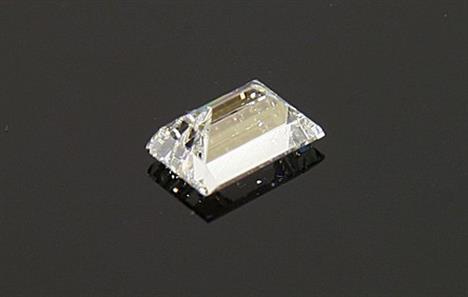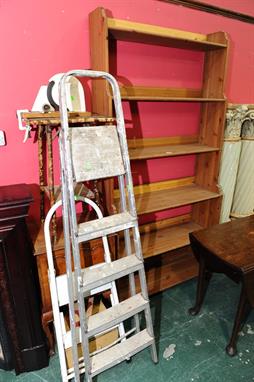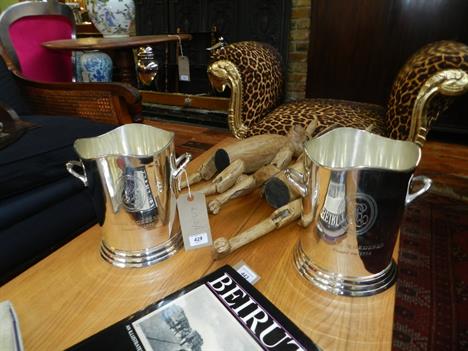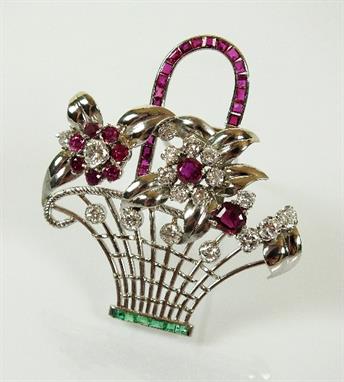We found 26534 price guide item(s) matching your search
There are 26534 lots that match your search criteria. Subscribe now to get instant access to the full price guide service.
Click here to subscribe- List
- Grid
-
26534 item(s)/page
Jaeger Le Coultre Mystery Clock Jaeger Le Coultre Gilt Bronze Pictorial Mystery Clock. The clock fashioned as a picture featuring gilt buzzing bees flying among sprays of weeds and grass against a rectangular frosted glass clock face, raised on a step dais, the dial with a chapter ring of Roman numerals, the wheel driven clock movement housed in a recessed center panel,stamped "Sixteen 16 Jewels Unadjusted" "Swiss Made". Height 7 7/8 inches (20 cm); length 7 1/8 inches (18 cm).
Emerald and diamond contemporary 18ct gold necklace and chain, the step cut to a wire work pendant with diamond points to the edge, on a baton link back chain, with a pair of emerald earstuds Condition Report: Set cut emerald 6mm x 4mm approximately, width of pendant 32mm approximately, length of chain 38cm approximately - ** General condition consistent with age
1950s period aquamarine and diamond necklace, the five graduated step cut stones separated by diamond set batons and stepped diamond set motifs beneath, the back chain tagged ‘9ct’, the brilliant and single cut diamonds totalling approximately 1.80 carats, largest aquamarine measures 12.8mm x 11.2mm, 38.5cm long Condition Report: ** General condition consistent with age No obvious signs of repairs or damage to the necklace, diamonds are fairly bright and white, no chips to the aquas, a couple of very small marks to the facet edge on a couple of stones,
Diamond and emerald ring, the emeralds arranged as three pairs of step cuts alternating with four bands of channel set diamonds, the twelve brilliant cuts totalling approximately 0.36 carats, stamped ‘750’, size M Condition Report: Slight chip to the corner of one emerald - ** General condition consistent with age
Sapphire and diamond cluster ring, the step cut of approximately 6.4mm in length, enclosed by twelve diamonds, the white mount stamped ‘18ct and Pt’, size P Condition Report: Slight facet wear to the sapphire and one claw damaged, width of head 10mm approximately, length 12mm approximately - ** General condition consistent with age
Tri-ang 00 Gauge Locomotives and Coaches; uncommon R357 AIA AIA blue Diesel with duck egg blue window surrounds, R152 BR green Diesel Shunter, SR green R 229 Restaurant Car and R221 Mainline Coach, all in original boxes, unboxed BR black 4-6-0 B12 Locomotive and Tender, G-E, B12 lacks one step under cab, boxes G-VG (5)
Tabula Geographica, in Qua Omnes Regiones, Urbes, Oppida, et Loca Describuntur, quorum mentio sit in Actis et Epistolis Apostolorum, et Apaocalypsi This superb, graphic map of the eastern Mediterranean, from Rome to Babylon, depicts the spread of Christianity as reported in the Acts of the Apostles. This is the final map of the standard set of five Holy Land maps normally found in Dutch Bibles. The map is surrounded by fifteen Biblical vignettes including the apostles receiving heavenly inspiration, and the events of the Apocalypse as in the book of Revelations. The map includes a small inset of the whole Mediterranean region and is further decorated with a compass rose, sailing ship and strapwork distance scale. This is the second state with Plancius` name in the cartouche replaced by D.R.M. Mathes. Dutch text on verso, from a Dutch Bible published by Cloppenburg. This is the second series of Dutch bible maps by Petrus Plancius, first published in 1604 by Johannes Cloppenburg. The first series consisted of a world map and 4 small maps of the Holy Land and Middle East, engraved by Johannes van Deutecum and his two sons, Johannes and Baptista. After Johannes van Deutecum (the younger) published a new set of maps in 1595, Plancius realized that his own maps required updating. He commissioned Baptista van Deutecum to engrave the second series, who also enlisted the assistance of engravers Daniel van Bremden and Pieter Bast. Plancius` second series retained the same world map and 6 larger, re-engraved maps of the Holy Land and Middle East. The purpose of the maps was to help explain the biblical texts, but Plancius decided to take the maps one step further by adding 15 biblical vignettes surrounding each map, thereby transforming each map into a work of art. Issued folding, now pressed with a 3"" tear adjacent to centerfold near bottom that has been professionally repaired. Remargined at both sides to accommodate framing. 11.3 W x 19.3 H Plancius/Cloppenburg, 1643
Arbuckles` Illustrated Atlas of Fifty Principal Nations of the World A nice example of this unusual atlas that was designed to advertise Arbuckles Coffee. The atlas is printed on loose pages held together with original twisted string tie. This oblong 4to atlas has 12 sheets, each with four beautiful chromolithographic maps. The front pictorial wrapper has a map of Palestine plus the western hemisphere with numerous cherubs around the bottom. The rear wrapper has a map of Brazil plus a view of the Arbuckle`s factory and two finely dressed women enjoying Arbuckle`s coffee. Text on facing page describes the map. Beginning in the mid-1880`s, the Arbuckle Bros. Coffee Company began to include advertising cards, commonly referred to as ""trade cards"" in packages of their coffee. This was a common device used by companies of the time to tout the virtues of their products. But the Arbuckle company carried the concept a step further and created a series of very desirable images. They then encouraged their customers to collect the entire series of cards and to trade cards with their neighbors in order to complete their sets. Thus, ""trade"" cards began to evolve into ""trading"" cards. Arbuckles issued a great variety of cards including birds, animals, cooking, satire, sports and maps. The map series, U.S. States and Nations of the World, were extremely popular. Both series were reissued in album format, available from the company as a mail-order premium. These fascinating cards and albums are still actively collected today, more than 120 years after they were issued. The original Arbuckle Bros. Coffee Company, on the other hand, vanished from the scene over 60 years ago. The maps are very good to near fine with the first two sheets containing small edge tears that just enter the image at top. There is a minor extraneous crease along the upper left portion of all sheets, and both covers are heavily chipped with a portion of the back cover missing. The front cover is separated and the back cover is loosely attached with cello tape. 7 W x 11.2 H Arbuckle Bros. Coffee Co., 1889
A Georgian foiled emerald and diamond cruciform brooch, a cushion cut diamond, set in a cut down collet at the centre, with two coffin shaped and two hexagonal step cut foil backed emeralds in yellow collets, in a cruciform position. Lines of graduated old European cut and old Swiss cut diamonds set between, with an outer row of diamonds in cut down collets. Closed back setting, a fold down pendant eyelet and later brooch fitting, in a later case by Tessiers, CONDITION REPORT: 12.2g approximately. 34mm x 29mm. Emeralds 7.5mm x 5.5mm approximately to 9.6mm x 7.2mm. As foiled, cannot comment on possible true colour. Some natural inclusions. One stone chipped. Diamonds bright. Centre cushion cut 5.27 x 4.87mm. No depths can be measured. Mount limitations apply. Closed back setting. The four other principle diamonds are: 3.75mm x 3.32mm; 3.70mm x 3.50mm; 3.80mm x 3.30mm; 3.72mm x 3.40mm.
An 18ct gold, emerald and diamond five stone carved head ring, with a central oval mixed cut emerald, an old European cut diamond to either side, with a rectangular step cut emerald to each end. All claw set to a carved head with pairs of rose cut diamond set points between. Sheffield 2012, probably a later hallmark. Finger size O CONDITION REPORT: Wear to the claws. one claw to the centre collet and one shoulder claw worn away, Crown facet edge wear and nibbles to the centre emerald. Facet edge wear to the others.
An unmounted rectangular step cut diamond of approximately 0.95ct, assessed as approximately: Colour: G/H Clarity: VS1/VS2 CONDITION REPORT: Polished girdle. When cut and polished a natural has been removed at one corner leaving a slightly rounded corner under 10x magnification. Very small indented naturals and additional facets to the upper pavillion corners.
(x) Great Britain1840 One Penny BlackPlate 1a, UsedIJ, good to very large margins all round, tied by red Maltese Cross cancellation in a chocolate-brown shade, to envelope, dated 7 May 1840, addressed to Adelphi, boxed datestamp on reverse, opening well for display and with step type "T.P./Kentish Town" handstamp alongside; a few minor cover faults but a most attractive second day of official use cover. Specialised £20,000 provenance:"Durham", November 1994Subject to 5% tax on Hammer Price in addition to 20% VAT on Buyer’s Premium. For more information please view Terms and Conditions for Buyers.
An emerald and diamond ring, the central step cut cut emerald four double claw set within an inner bezel of twenty nine brilliant cut claw set diamonds, in turn set within an outer bezel of thirty seven brilliant cut claw set diamonds, all set in an open double mount between open shoulders each set with six uniform brilliant cut claw set diamonds, on a plain band. Ring size R. Certified Colombian Emerald, accompanied by certificate number 05425, issued by The Gem and Pearl Laboratory, 23 March 2012.
A good quality 48 bore flintlock duelling or officers pistol c 1785, 14½ overall, heavy sighted flat topped round barrel 9 engraved D. Egg-London, the plain flat stepped lock signed Lett in script, with flat swan neck cock, roller on frizzen and raised ramp on frizzen spring, the step of the lock being the concealed safety catch, walnut fullstock with shell carving around the flower engraved breech tang, and with oval silver escutcheon engraved with the initials RK surrounded by twisted silver band, the blued steel mounts including finely flower engraved trigger guard with acorn finial, single set trigger, and engraved domed butt cap, original horn tipped ramrod with steel worm. Good Working Order and generally Crisp Condition, the mounts retaining most original blued finish (the barrel rebrowned, very minor repair to split in fore end) Plate 36
DU MAURIER DAPHNE: (1907-1989) British Author. T.L.S., Daphne, four pages, 8vo, Menabilly, Par, Cornwall, 25th November 1966, to 'My dear' (Foy Quiller-Couch). Du Maurier writes of some repairs being carried out at her home, Kilmarth, commenting 'there is scaffolding all around it, and men hurrying about like ants all over the property - at my expense, of course! My lawyer said we must start on repairs, whether I end up there or not, so a Mr. Pascoe from St. Austell has been engaged to do the work with a team of minions. He is semi-royal, what I mean is I shake hands with him, but he seems to be shy, for whenever I drive up there to see what is going on he backs into the bushes, and two weeks ago nearly fell to his doom down a well in the garden that nobody knew was there' and further writes of the garden and the help of a gentleman from the National Trust, 'I call him U Thant - for he is a sort of mediator between me and the Estate, and wants to save my purse at every step. I wish a leaseholder, as I am, could enter some agreement or covenant with them, but I doubt if I can.' Du Maurier also refers to her work, 'Kits and I are trying to make a film script out of Vanishing Cornwall, so that he could make a documentary film, in colour, out of the book, and if we can get some assurance from a film company or a television company, to back us, he will come down in January and we shall proceed to film it….I imagine the filming would take about a month, or even more, depending a lot on the weather…' A couple of light, small tape stains to the head of the first and final pages, only slightly affecting two words of text, and not the signature, otherwise VG Foy Quiller-Couch - daughter of British writer Arthur Quiller-Couch (1863-1944), and a life-long friend of Du Maurier. Indeed, Du Maurier was accompanied by Foy Quiller-Couch when she became inspired with the storyline for her novel Jamaica Inn. Some years previously the two ladies were staying at Jamaica Inn and went riding on Bodmin Moor. They became lost in bad weather conditions and apparently sheltered for some time in a derelict cottage on the moor but were eventually led back to Jamaica Inn by their horses.
GEORGE V: (1865-1936) King of the United Kingdom 1910-36. A.L.S., George P, as Prince of Wales, two pages, 8vo, Frogmore House, Windsor, 2nd June 1909, to 'My dear Sandhurst'. The Prince states that Bigge has just shown him Sandhurst's letter and continues 'So I hasten to send you one line to offer you the warm congratulations of the Princess & myself on your engagement to Mrs. Armine Woodhouse (sic). I trust that this step may bring you both much happiness' and concludes 'Having known you for so many years I am naturally interested in anything that concerns your happiness'. With blank integral leaf. VG William Mansfield, 1st Viscount Sandhurst (1855-1921) British Politician, Lord Chamberlain of the Household 1912-21. His second wife was Eleanor Arnold, daughter of Matthew Arnold and widow of Armine Wodehouse. They married on 5th July 1909.
A pair of early 20th Century Neoclassical Revival mahogany side cabinets, each pagoda moulded top above a step fluted frieze fitted with a drawer, each panelled door inset with fabric flanked by carved acanthus leaf corners, on ogee bracket feet, height approx 81cm, width approx 69cm (alterations).
A diamond, ruby and emerald set giardinetto brooch, designed as a woven white metal wire work basket with channel set emerald base issuing two ruby and diamond set flowers, within ruby and diamond set white metal leaves, the basket handle channel set with step cut rubies, the reverse with dual hinged pin, not stamped, all 52mm high, 49mm wide, weight 25gms
-
26534 item(s)/page


























































